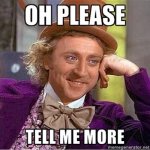Kharakov
Quantum Hot Dog
Ok, but you're being nonsensical. Nothing means the complete absence of everything. Nothing causes nothing (it has no properties that would allow it to cause something). Nothing does nothing (it does not act). Nothing doesn't change (it has no qualities to change).
If nothing exists at some future time a, at any point past time a, nothing will also exist, as there isn't anything, even a quantum mechanical physical framework, to cause something to pop into existence.
I would have thought that a moment in time is something. You can't have a moment in time when there is nothing because the moment itself is something.
I went over that a bit earlier, but I do understand your point (bilby pointed it out as well). The thing is, I said "at some future time a", so we can imagine ehhhhs existence, at which point nothing exists (even the concept of the time ehhhhh).
If I said "at time ehhhh", sure. I mean, I think that I said "future time ehhhh" on purpose, because I was thinking about what you're saying, but... I forget. And I certainly forgot when bilby pointed it out, until I read what I wrote more carefully (I just assumed that I had miss-wrote, which is pretty cray cray for me to assume about stuff I write when I'm sober).


